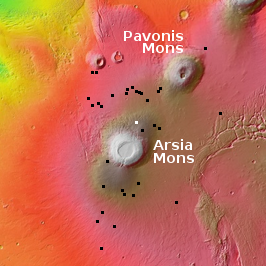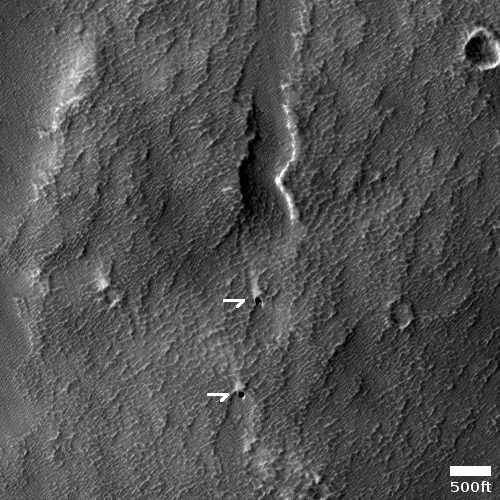Two skylights into connected Martian lava tube?
Cool image time! The photo to the right, cropped and annotated to post here, was taken on September 1, 2021 by the high resolution camera on Mars Reconnaissance Orbiter (MRO). I have annotated it to note the two apparent skylights that appear aligned along a north-south depression.
The grade is downhill to the north. If you look at the full image you will see that this north-south depression extends for a considerable distance beyond the edges of the cropped image above, with that depression appearing to dissipate to the north into a series of parallel very shallow depressions, almost like the lava had flowed out of the tube and formed branching surface rivulets heading south.
The overview map shows that this tube is on the northern flanks of the volcano Arsia Mons.

The white box notes the location of these two skylights and hypothesized lava tube. The black boxes note the location of every single pit or lava tube in this region that I have previously featured as a cool image on Behind the Black. (For a listing of most of these posts go here.) These pits however form only a partial selection of the numerous such pits scientists have identified surrounding Arsia Mons.
Why there are white streaks to north edge of both pits is unknown. While it could be dust deposited by the prevailing winds, that theory doesn’t fit with the white cliff to the north. I also wonder if the winds cutting across the top of these holes could function much like a flutist blowing across his flute’s mouthpiece to produce sound. At these holes a similar wind might cause material to be pulled up out of the holes.
All guesses. We don’t even know if the skylights are connected by a lava tube underground. The depression might simply be signaling the long ago filling of that void.
On Christmas Eve 1968 three Americans became the first humans to visit another world. What they did to celebrate was unexpected and profound, and will be remembered throughout all human history. Genesis: the Story of Apollo 8, Robert Zimmerman's classic history of humanity's first journey to another world, tells that story, and it is now available as both an ebook and an audiobook, both with a foreword by Valerie Anders and a new introduction by Robert Zimmerman.
The print edition can be purchased at Amazon or from any other book seller. If you want an autographed copy the price is $60 for the hardback and $45 for the paperback, plus $8 shipping for each. Go here for purchasing details. The ebook is available everywhere for $5.99 (before discount) at amazon, or direct from my ebook publisher, ebookit. If you buy it from ebookit you don't support the big tech companies and the author gets a bigger cut much sooner.
The audiobook is also available at all these vendors, and is also free with a 30-day trial membership to Audible.
"Not simply about one mission, [Genesis] is also the history of America's quest for the moon... Zimmerman has done a masterful job of tying disparate events together into a solid account of one of America's greatest human triumphs."--San Antonio Express-News
Cool image time! The photo to the right, cropped and annotated to post here, was taken on September 1, 2021 by the high resolution camera on Mars Reconnaissance Orbiter (MRO). I have annotated it to note the two apparent skylights that appear aligned along a north-south depression.
The grade is downhill to the north. If you look at the full image you will see that this north-south depression extends for a considerable distance beyond the edges of the cropped image above, with that depression appearing to dissipate to the north into a series of parallel very shallow depressions, almost like the lava had flowed out of the tube and formed branching surface rivulets heading south.
The overview map shows that this tube is on the northern flanks of the volcano Arsia Mons.

The white box notes the location of these two skylights and hypothesized lava tube. The black boxes note the location of every single pit or lava tube in this region that I have previously featured as a cool image on Behind the Black. (For a listing of most of these posts go here.) These pits however form only a partial selection of the numerous such pits scientists have identified surrounding Arsia Mons.
Why there are white streaks to north edge of both pits is unknown. While it could be dust deposited by the prevailing winds, that theory doesn’t fit with the white cliff to the north. I also wonder if the winds cutting across the top of these holes could function much like a flutist blowing across his flute’s mouthpiece to produce sound. At these holes a similar wind might cause material to be pulled up out of the holes.
All guesses. We don’t even know if the skylights are connected by a lava tube underground. The depression might simply be signaling the long ago filling of that void.
On Christmas Eve 1968 three Americans became the first humans to visit another world. What they did to celebrate was unexpected and profound, and will be remembered throughout all human history. Genesis: the Story of Apollo 8, Robert Zimmerman's classic history of humanity's first journey to another world, tells that story, and it is now available as both an ebook and an audiobook, both with a foreword by Valerie Anders and a new introduction by Robert Zimmerman.
The print edition can be purchased at Amazon or from any other book seller. If you want an autographed copy the price is $60 for the hardback and $45 for the paperback, plus $8 shipping for each. Go here for purchasing details. The ebook is available everywhere for $5.99 (before discount) at amazon, or direct from my ebook publisher, ebookit. If you buy it from ebookit you don't support the big tech companies and the author gets a bigger cut much sooner.
The audiobook is also available at all these vendors, and is also free with a 30-day trial membership to Audible.
"Not simply about one mission, [Genesis] is also the history of America's quest for the moon... Zimmerman has done a masterful job of tying disparate events together into a solid account of one of America's greatest human triumphs."--San Antonio Express-News



So … that is where they have been hiding …?
Pardon me, … I live too close to the Lassen lava tubes.
Nice places to hole up for future reference perhaps ?
Wondering what this may be used for…a flow in one hole and out the other.